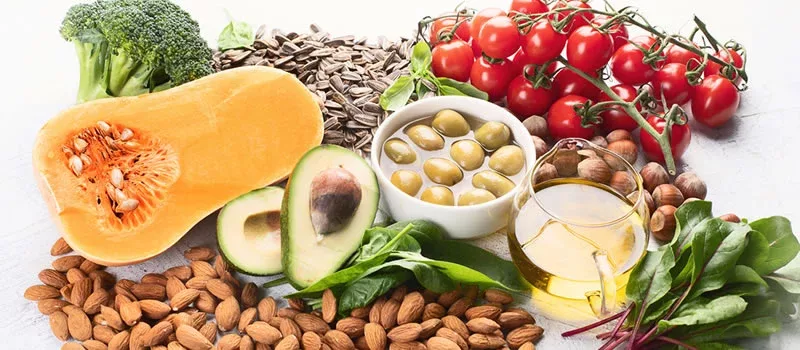
The Benefits of Vitamin E
In this article
What are the benefits of vitamin E
In particular, the vitamin E benefits for our skin are such that vitamin E plays a key role in protecting our skin against UV radiation and other free radicals that the epidermis (the outer layer of the skin) may come into contact with. Though both vitamin E and vitamin C may be required to increase photoprotection (the biochemical process that protects your skin from sunlight). Topical vitamin E has shown to be effective in providing photoprotection.
Vitamin E benefits also include keeping the immune system functioning properly.
Additional vitamin E benefits are its antioxidant status and therefore, the capacity to fight free radicals in the body.
How much vitamin E do you need
How much vitamin E each person needs will depend on gender and age.
The following table outlines the recommended amount for different life stages.
| Life Stage | Adequate Intake per Day |
| Birth – 6 months | 4 mg |
| Infants 7 – 12 months | 5 mg |
| Children 1 – 3 years | 5 mg |
| Children 4 – 8 years | 6 mg |
| Children 9 – 13 years | Girls – 8 mg, Boys – 9 mg |
| Teens 14 – 18 years | Girls – 8 mg, Boys – 10 mg |
| Adults 19+ yrs | Women – 7 mg, Men – 10 mg |
| Pregnant teenagers and women |
14-18 yrs – 8 mg 19-50 yrs – 7 mg
|
| Breastfeeding teenagers and women |
14-18 yrs – 12 mg 19-50 yrs – 11 mg |
It is uncommon for people to require Vitamin E supplements and can be harmful if taken in large doses, particularly for people who are on blood thinners such as warfarin and some cholesterol medication.
What foods contain vitamin E
Vitamin E is found in found naturally in plant-based oils, including canola, corn, sunflower and soybean. Vitamin E foods include nuts (almonds, peanuts, hazelnuts) and seeds (particularly sunflower seeds) and fortified cereals. Other vitamin E sources include meat, fish, dairy foods and green leafy vegetables.
In terms of how much each vitamin E source provides 1 tablespoon of wheat germ oil contains 20mg of vitamin E, 30g sunflower seeds have about 7.5 mg of vitamin E, 30g (about 20 almonds) will typically offer around 7mg of vitamin E, while one tablespoon of sunflower oil contains about 5.5mg of the vitamin E.
Consequences of vitamin E deficiency
It is not common for healthy people to have Vitamin E deficiency. Usually, Vitamin E deficiency is linked to conditions where fat is not absorbed or digested properly because vitamin E requires fat to be absorbed.
Vitamin E deficiency can cause damage to nerve and muscles damage resulting in loss of control over body movements and lost feeling in the arms and legs, muscle weakness, and problems with vision. Having a weakened immune system is another sign of Vitamin E deficiency.
There is little evidence that a deficiency in vitamin E may affect skin health. Studies in rats show that a vitamin E deficiency can cause skin ulcerations and change the cross-linking in skin collagen but it is unknown why this occurred.
How can Nature’s Own help
If you feel that vitamin E may be beneficial for you, please consult your GP first.
If you are curious to see how Nature’s Own may help, see which Nature’s Own product may be appropriate for you.